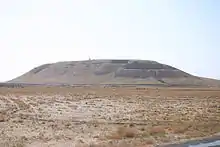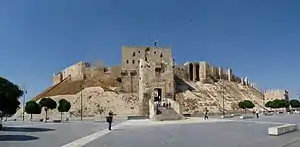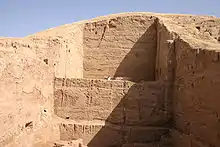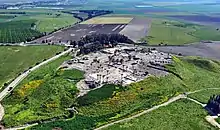Tell (archaeology)
In archaeology, a tell or tel (borrowed into English from Arabic: تَل, tall, 'mound' or 'small hill')[1] , is an artificial topographical feature, a species of mound[lower-alpha 1] consisting of the stratified debris from the accumulated refuse of generations of people who once formed a settlement and dwelt on the same site.[3][lower-alpha 2] A classic tell looks like a low, truncated cone with sloping sides[5] and a flat, mesa-like top.[6] They can be more than 43 m (141 ft) high.[7]


Tells are formed from a variety of remains, including organic and cultural refuse, collapsed mudbricks and other building materials, water-laid sediments, residues of biogenic and geochemical processes, and aeolian sediment.[8] Tells are most commonly associated with the ancient Near East, but they are also found elsewhere, such as Southern Europe from Bulgaria to Greece[9] and in North Africa.[10] [3][11][12] Within the Near East, they are concentrated in less arid regions, including Upper Mesopotamia, the Southern Levant, Anatolia and Iran, which had more continuous settlement.[13]
Etymology
Tell has many cognates in Semitic languages, such as Ugaritic tl, Hebrew tel (תל) and Akkadian tillu(m). The Akkadian form corresponds to Sumerian DUL (which can also refer to a 'pile' of any material, like grain), but it is not known whether the similarity reflects a borrowing from that language, or if the Sumerian term itself was a loanword from an earlier Semitic substrate language.[14] If Akkadian tillu is related to another word in that language, til'u, meaning ‘woman’s breast’, there exists a similar term in the South Semitic classical Ethiopian language of Geʽez, namely təla/breast.[15]
There are lexically unrelated equivalents for this geophysical concept of a town-mound in other Southwest Asian languages, including kom in Egyptian Arabic,[16] tepe or tappeh (Turkish/Persian: تپه), hüyük or höyük (Turkish), and chogha (Persian: چغا).[7] These often appear in place names,[17] and the word itself is one of the commonest prefixs for Palestinian toponyms.[18] The Arabic word khirbet or khirbat (خربة), meaning 'ruin', also occurs in the names of many archaeological tells, such as Khirbet et-Tell (lit.'heap of ruins').[19]
Tell is first attested in English in 1840 in a report in the Journal of the Royal Geographical Society.[20] Variant spellings include tall, tel, til, and tal. [17]
Middle East

It is thought that the earliest examples of tells are to be found in the Jordan Valley, such as at the 10 meter-high mound, dating back to the proto-Neolithic period, at Jericho in the West Bank.[3] Upwards of 5,000 tells have been detected in the area of ancient Israel,(including the area covered by modern Israel and Palestine) and Jordan.[21] Of these Paul Lapp calculated in the 1960s that 98% had yet to be touched by archaeologists.[21]
European tells
Northeastern Bulgaria has a rich archaeological heritage of eneolithic [lower-alpha 3] tells from the 5th millennium BCE.[23]
In Neolithic Greece, there is a contrast between the northern Thessalian plain where rainfall was sufficient to permit densely populated settlements based on dry-farming and the more dispersed sites in southern Greece, such as the Peloponesus, where early villages sprang up around the smaller arable tracts close to springs, lakes and marshes.[24] There are two models to account for the tell structures of this part of southern Europe, one developed by Paul Halstead and the other by John Chapman. Chapman envisaged the tell as witness to a nucleated communal society, whereas Halstead emphasized the idea that they arose as individual household structures. [25] Thessalian tells often reflect small hamlets with a small population of around 40-80.[26]
Notes and references
Explanatory notes
- 'Artificial mounds are a characteristic feature of permanent and semipermanent settlement locations in past cultural landscapes, particularly on sedimentary plains, but also in arid and semiarid regions.'[2]
- ’It is a paradox that a tell cannot by definition begin life as a tell – its earliest incarnation is as a flat site, like other flat sites in its vicinity. Such places did not take on the visual characteristics of tells for some generations but remained in statu nascendi. There is a critical time between the first reoccupation of a placed and the physical manifestation of a mound-a period of generations, if not centuries… The physical transformation of a tell-to-be into a tell depends upon two long-term physical concentrations – of people and house daub.. The nucleation of people in households living close to one another is the first prerequisite of tell-becoming.’[4]
- 4900-3800 B.C.E.[22]
Notes
- Kirkpatrick, E. M., ed. (1983). Chambers 20th Century Dictionary (New ed.). Edinburgh: W & R Chambers Ltd. p. 1330. ISBN 0550102345.
- Orengo&al 2020, p. 18240.
- Shaw 2002, p. 566.
- Chapman 2000, p. 207.
- Albright 1949, p. 16.
- Suriano 2012, p. 213.
- Matthews 2020, p. 7260.
- Wilkinson 2003, p. 108.
- Bailey&al 1998, p. 373-396.
- MacDonald 1997, pp. 40-42.
- Davidson&al 2010, pp. 1564–1571.
- Kotsakis 1999, p. 66.
- Wilkinson 2003, pp. 100-127.
- Suriano 2012, p. 214, notes 17-19.
- Leslau 1958, p. 55.
- Shaw 2002, p. 567.
- Hirst 2019.
- Warfield 1885, p. 274.
- Wagemakers 2014, p. 40.
- "tell". Oxford English Dictionary (Online ed.). Oxford University Press. (Subscription or participating institution membership required.)
- Lapp 1975, p. 1.
- Bailey&al 1998, p. 375).
- Bailey&al 1998, p. 378.
- Bintliff 2012, p. 53.
- Bintliff 2012, pp. 53-54.
- Bintliff 2012, p. 55.
References
- Albright, William Foxwell (1949). The Archaeology of Palestine. Penguin Books. pp. 7–22.
- Bailey, Douglass; Tringham, Ruth; Bass, Jason; Stevanović, Mirjana; Hamilton, Mike; Neumann, Heike; Angelova, Ilke; Raduncheva, Ana (Winter 1998). "Expanding the Dimensions of Early Agricultural Tells: The Podgoritsa Archaeological Project, Bulgaria". Journal of Field Archaeology. 25 (4): 373–396. JSTOR 530635.
- Bintliff, John (2012). The Complete Archaeology of Greece: From Hunter-Gatherers to the 20th Century A.D. John Wiley & Sons. ISBN 978-1-118-25520-9.
- Chapman, John (2000). Fragmentation in Archaeology: People, Places, and Broken Objects in the Prehistory of South-eastern Europe. Psychology Press. ISBN 978-0-415-15803-9.
- Davidson, Donald A.; Wilson, Clare A.; Lemos, Irene S.; Theocharopoulos, S. P. (2010-07-01). "Tell formation processes as indicated from geoarchaeological and geochemical investigations at Xeropolis, Euboea, Greece". Journal of Archaeological Science. 37 (7): 1564–1571. doi:10.1016/j.jas.2010.01.017. hdl:1893/16434.
- Hirst, K. Kris (22 March 2019). "What Is a Tell? The Remnants of Ancient Mesopotamian Cities". ThoughtCo.
- Kotsakis, Kostas (1999). "What Tells can Tell: Social Space and Settlement in the Greek Neolithic". In Halstead, Paul (ed.). Neolithic Society in Greece. Sheffield Academic Press. ISBN 978-1-850-75824-2.
- Lapp, Paul W. (1975). Lapp, Nancy L.; Hadidian, Fikran (eds.). The Tale of the Tell: Archaeological Studies by Paul W. Lapp. Wipf and Stock Publishers. ISBN 978-1-725-24234-0.
- Leslau, Wolf (1958). Ethiopic and South Arabic Contributions to the Hebrew Lexicon. XX. University of California Publicans in Semitic Philology.
- Lloyd, Seton (1963). Mounds of the Near East. Edinburgh University Press.
- MacDonald, Kevin C. (23 November 1997). "More forgotten tells of Mali: an archaeologist's journey from here to Timbuktu" (PDF). Archaeology International. 1 (1): 40–42. doi:10.5334/ai.v1i0.216.
- Matthews, Wendy (2020). "Tells in Archaeology". In Smith, Claire (ed.). Encyclopedia of Global Archaeology. Springer. pp. 7259–7262. ISBN 978-3-030-30016-6.
- Orengo, Hector A.; Conesa, Francesc C.; Garcia-Molsosa, Arnau; Lobo, Agustín; Green, Adam S.; Madella, Marco; Petrie, Cameron A. (4 August 2020). "Automated detection of archaeological mounds using machine-learning classification of multisensor and multitemporal satellite data" (PDF). PNAS. 117 (31): 18240–18250. doi:10.1073/pnas.2005583117. PMC 7414161. PMID 32690717.
- Shaw, Ian (2002). "Tell". In Shaw, Ian; Jameson, Robert (eds.). A Dictionary of Archaeology. John Wiley & Sons. pp. 566–567. ISBN 978-0-631-23583-5.
- Small, David B. (2019). The Ancient Greeks: Social Structure and Evolution. Cambridge University Press. ISBN 978-0-521-89505-7.
- Suriano, Matthew J. (2012). "Ruin Hills at the Threshold of the Netherworld: The Tell in the Conceptual Landscape of the Ba'al Cycle and Ancient Near Eastern Mythology". Die Welt des Orients. 42 (2): 210–230. doi:10.13109/wdor.2012.42.2.210. JSTOR 23342127.
- Wagemakers, Bart (2014). "Khirbet Et-Tell (Ai?)". Archaeology in the 'Land of Tells and Ruins': A History of Excavations in the Holy Land Inspired by the Photographs and Accounts of Leo Boer. Oxbow Books. ISBN 978-1-782-97245-7.
- Warfield, Benjamin (1885). "The Scenes of the Baptist's Work". In Nicoll, W. Robertson (ed.). The Expositor. Hodder and Stoughton. pp. 267–282.
- Wilkinson, Toby J. (2003). Archaeological Landscapes of the Near East. University of Arizona Press. pp. 100–127. ISBN 978-0-816-52173-9.
External links
 Media related to Tell (archeology) at Wikimedia Commons
Media related to Tell (archeology) at Wikimedia Commons


